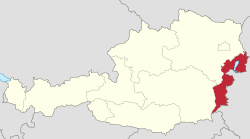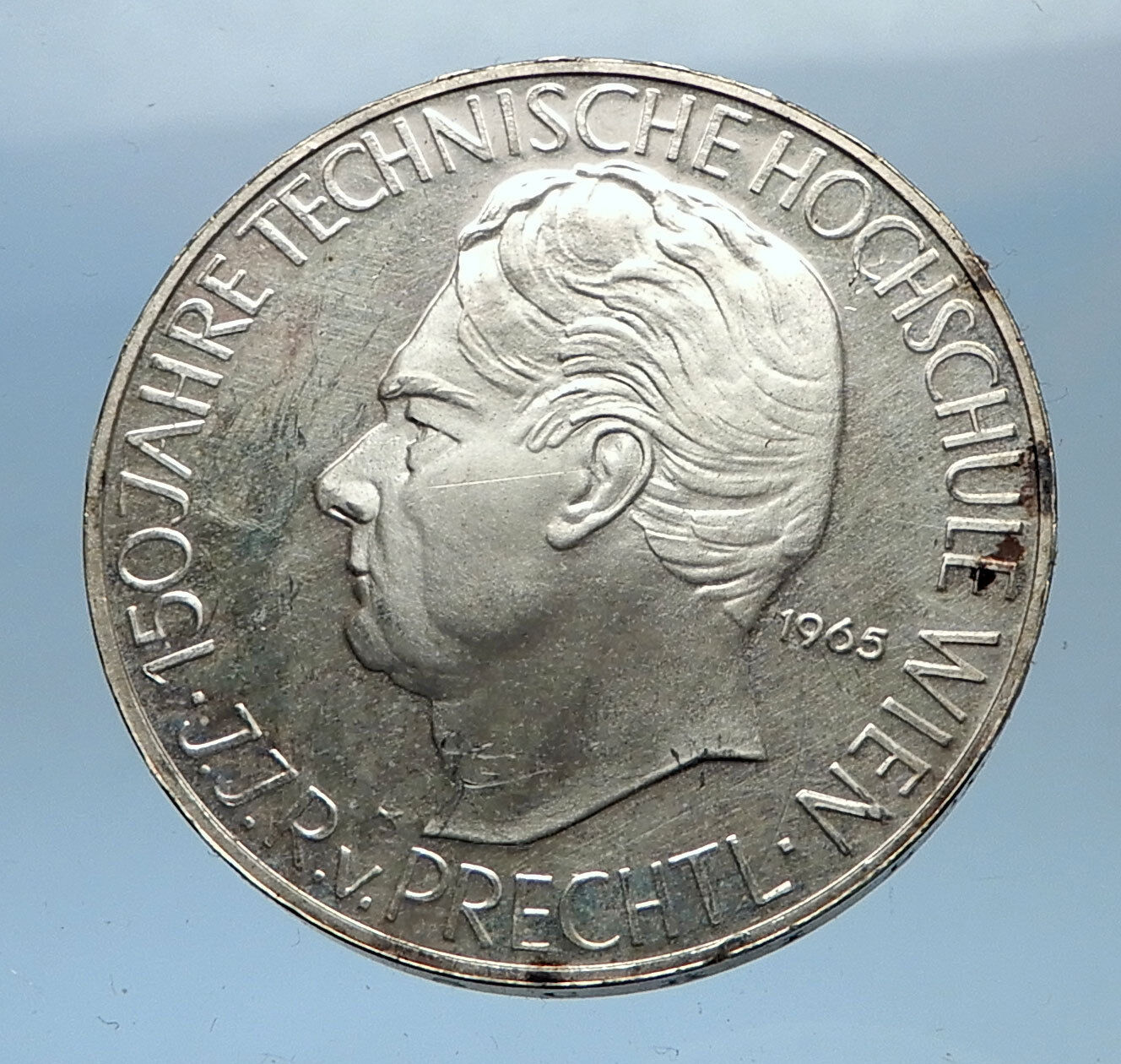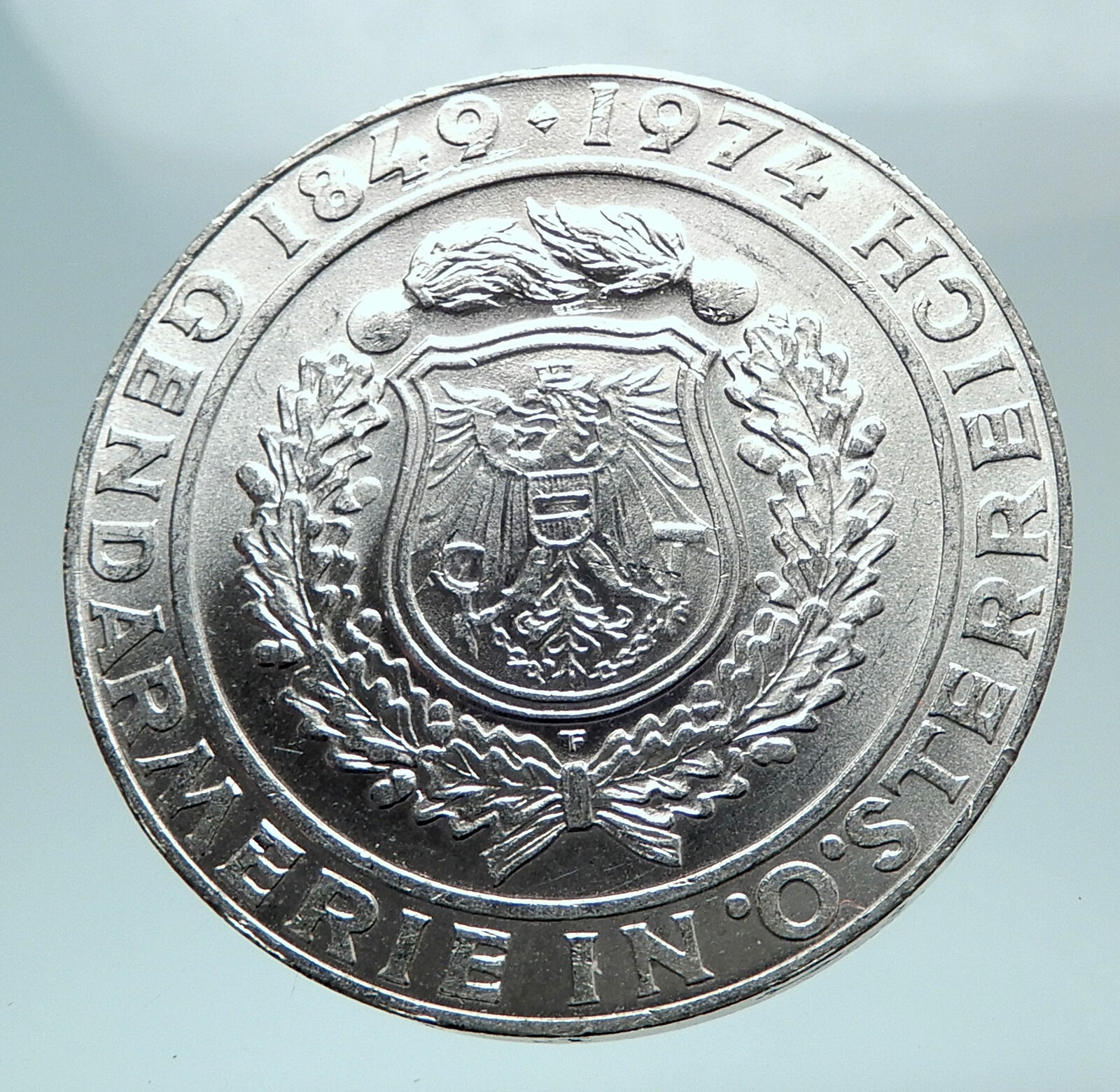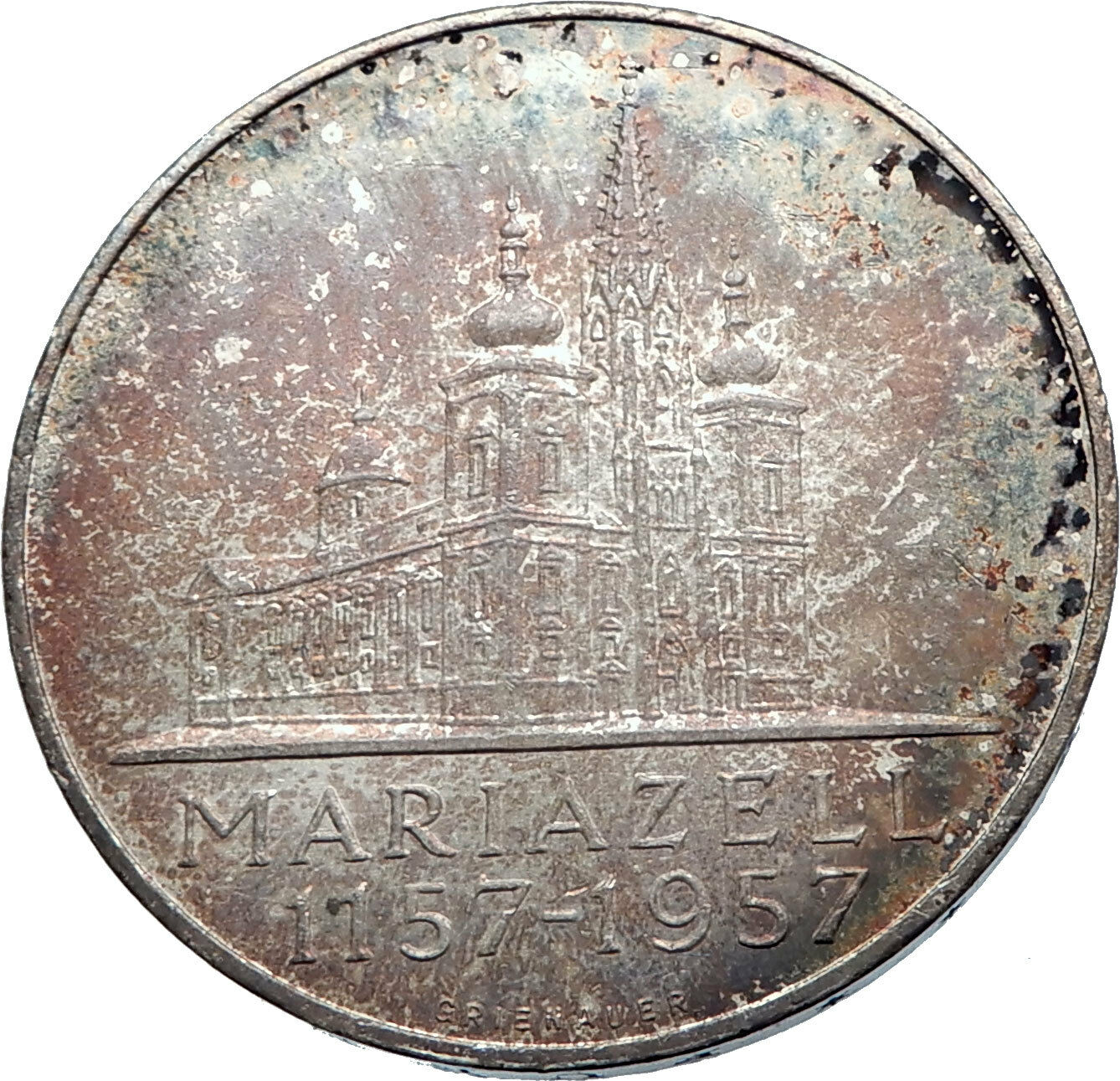|
Austria – 40th Anniversary of Burgenland
1961 Silver 25 Schilling 30mm (12.94 grams) 0.800 Silver (0.3344 oz. ASW)
Reference: KM# 2891
REPUBLIK ÖSTERREICH 25 SCHILLING, Value within beaded circle, surrounded by the nine heraldic shields of the Austrian provinces, small sprays below.
40 JAHRE BURGENLAND 1921-1961, Mountain church on Calvary in Eisenstadt (Burgenland, Austria).
Edge Lettering: FUENFZIG SCHILLING
You are bidding on the exact item pictured, provided with a Certificate of Authenticity and Lifetime Guarantee of Authenticity.
 Burgenland is the easternmost and least populous state of Austria. It consists of two statutory cities and seven rural districts, with in total 171 municipalities. It is 166 km (103 mi) long from north to south but much narrower from west to east (5 km (3.1 mi) wide at Sieggraben). The region is part of the Centrope Project. Burgenland is the easternmost and least populous state of Austria. It consists of two statutory cities and seven rural districts, with in total 171 municipalities. It is 166 km (103 mi) long from north to south but much narrower from west to east (5 km (3.1 mi) wide at Sieggraben). The region is part of the Centrope Project.
The territory of present-day Burgenland was successively part of the Roman Empire, the Hun Empire, the Kingdom of the Ostrogoths, the Italian Kingdom of Odoacer, the Kingdom of the Lombards, the Avar Khaganate, the Frankish Empire, Dominion Aba belonging to the Aba (family); Aba – Koszegi, the Kingdom of Hungary, the Habsburg Monarchy, the Austrian Empire, Austria-Hungary, Austria.
Burgenland is the only Austrian state which has never been part of the Archduchy of Austria, Holy Roman Empire, German Confederation nor Austria-Hungary’s Cisleithania.
Prehistory and antiquity
 The first Indo-European peoples appeared in this region around 3300 BC.[citation needed] From the 4th century BC, the area was dominated by Celts and in the 1st century AD it became part of the Roman Empire. During Roman administration, it was part of the province of Pannonia, and later part of the provinces of Pannonia Superior (in the 2nd century) and Pannonia Prima (in the 3rd century). During the late Roman Empire, Pannonia Prima province was part of larger administrative units, such are Diocese of Pannonia, Praetorian prefecture of Illyricum and Praetorian prefecture of Italy. The first Indo-European peoples appeared in this region around 3300 BC.[citation needed] From the 4th century BC, the area was dominated by Celts and in the 1st century AD it became part of the Roman Empire. During Roman administration, it was part of the province of Pannonia, and later part of the provinces of Pannonia Superior (in the 2nd century) and Pannonia Prima (in the 3rd century). During the late Roman Empire, Pannonia Prima province was part of larger administrative units, such are Diocese of Pannonia, Praetorian prefecture of Illyricum and Praetorian prefecture of Italy.
Early Germanic states
The first Germanic people to settle in this region were the Ostrogoths, who came to Pannonia in AD 380. The Ostrogoths became allies of Rome and were allowed to settle in Pannonia, being tasked to defend the Roman borders. In the 5th century, the area was conquered by the Huns, but after their defeat, an independent Kingdom of the Ostrogoths in Pannonia was formed. The territory of present-day Burgenland became part of the Italian Kingdom of Odoacer, but at the end of the 5th century the Ostrogothic king Theodoric conquered this kingdom and restored Ostrogothic administration in western Pannonia.
In the 6th century, the territory was included in another Germanic state, the Kingdom of the Lombards. However, the Lombards subsequently left towards Italy and the area came under the control of the Avars. Briefly in the 7th century, the area was part of the Slavic State of Samo, but was subsequently returned to Avar control. After the Avar defeat at the end of the 8th century, the area became part of the Frankish Empire. After the Battle of Lechfeld (or Augsburg) in 955, new Germanic settlers came to the area.
 According to the 1910 census 291,800 people lived on the territory of present-day Burgenland. Among them 217,072 were German-speaking (74%), 43,633 Croatian-speaking (15%) and 26,225 (9%) Hungarian-speaking. Roma people were counted according to their native language. According to the 1910 census 291,800 people lived on the territory of present-day Burgenland. Among them 217,072 were German-speaking (74%), 43,633 Croatian-speaking (15%) and 26,225 (9%) Hungarian-speaking. Roma people were counted according to their native language.
From March to August 1919, the Burgenland was part of the Hungarian Soviet Republic.
The area had also been discussed as the site of a Czech Corridor to Yugoslavia. The decision about “German West Hungary” (Deutsch-Westungarn) was fixed in the peace treaties of Saint Germain and Trianon. Despite diplomatic efforts by Hungary, the victorious parties of World War I set the date of Burgenland’s official unification with Austria as 28 August 1921. In fact, the establishment of Austrian police control and customs was stopped on the same day, hindered by sharpshooters who offered armed resistance with the support of Hungary. Lieutenant Colonel Pál Prónay with his men, the Rongyos Gárda defended Western Hungary from the occupying Austrian officials, and forces of the Austrian Gendarmerie. He had help from the Hungarian and Croatian people, who did not want to live under Austrian rule. That became the Uprising in West Hungary in 1921. Prónay created the short state of Lajtabánság. Austria annexed the Western territory of Moson County, Sopron County, Vas County and Zala County with the help of the victorious’ powers of World War I. In 1921, general elections were held in the area and as a result of that Sopron and surrunding larger territories were voted to stay in Hungary thus the Hungarian occupation ot the other territories ended. These areas was later handed over to Austria and Burgenland was created.
  Austria, officially the Republic of Austria (German: Republik Österreich), is a federal republic and a landlocked country of over 8.5 million people in Central Europe. It is bordered by the Czech Republic and Germany to the north, Hungary and Slovakia to the east, Slovenia and Italy to the south, and Switzerland and Liechtenstein to the west. The territory of Austria covers 83,879 square kilometres (32,386 sq mi). Austria’s terrain is highly mountainous, lying within the Alps; only 32% of the country is below 500 metres (1,640 ft), and its highest point is 3,798 metres (12,461 ft). The majority of the population speak local Bavarian dialects of German as their native language, and Austrian German in its standard form is the country’s official language. Other local official languages are Hungarian, Burgenland Croatian, and Slovene. Austria, officially the Republic of Austria (German: Republik Österreich), is a federal republic and a landlocked country of over 8.5 million people in Central Europe. It is bordered by the Czech Republic and Germany to the north, Hungary and Slovakia to the east, Slovenia and Italy to the south, and Switzerland and Liechtenstein to the west. The territory of Austria covers 83,879 square kilometres (32,386 sq mi). Austria’s terrain is highly mountainous, lying within the Alps; only 32% of the country is below 500 metres (1,640 ft), and its highest point is 3,798 metres (12,461 ft). The majority of the population speak local Bavarian dialects of German as their native language, and Austrian German in its standard form is the country’s official language. Other local official languages are Hungarian, Burgenland Croatian, and Slovene.
 The origins of modern-day Austria date back to the time of the Habsburg dynasty when the vast majority of the country was a part of the Holy Roman Empire. From the time of the Reformation, many Northern German princes, resenting the authority of the Emperor, used Protestantism as a flag of rebellion. The Thirty Years War, the influence of the Kingdom of Sweden and Kingdom of France, the rise of the Kingdom of Prussia, and the Napoleonic invasions all weakened the power of the Emperor in the North of Germany, but in the South, and in non-German areas of the Empire, the Emperor and Catholicism maintained control. During the 17th and 18th centuries, Austria was able to retain its position as one of the great powers of Europe and, in response to the coronation of Napoleon as the Emperor of the French, the Austrian Empire was officially proclaimed in 1804. Following Napoleon’s defeat, Prussia emerged as Austria’s chief competitor for rule of a larger Germany. Austria’s defeat by Prussia at the Battle of Königgrätz, during the Austro-Prussian War of 1866 cleared the way for Prussia to assert control over the rest of Germany. In 1867, the empire was reformed into Austria-Hungary. After the defeat of France in the 1870 Franco-Prussian War, Austria was left out of the formation of a new German Empire, although in the following decades its politics, and its foreign policy, increasingly converged with those of the Prussian-led Empire. During the 1914 July Crisis that followed the assassination of Archduke Franz Ferdinand of Austria, Germany guided Austria in issuing the ultimatum to Serbia that led to the declaration of World War I. The origins of modern-day Austria date back to the time of the Habsburg dynasty when the vast majority of the country was a part of the Holy Roman Empire. From the time of the Reformation, many Northern German princes, resenting the authority of the Emperor, used Protestantism as a flag of rebellion. The Thirty Years War, the influence of the Kingdom of Sweden and Kingdom of France, the rise of the Kingdom of Prussia, and the Napoleonic invasions all weakened the power of the Emperor in the North of Germany, but in the South, and in non-German areas of the Empire, the Emperor and Catholicism maintained control. During the 17th and 18th centuries, Austria was able to retain its position as one of the great powers of Europe and, in response to the coronation of Napoleon as the Emperor of the French, the Austrian Empire was officially proclaimed in 1804. Following Napoleon’s defeat, Prussia emerged as Austria’s chief competitor for rule of a larger Germany. Austria’s defeat by Prussia at the Battle of Königgrätz, during the Austro-Prussian War of 1866 cleared the way for Prussia to assert control over the rest of Germany. In 1867, the empire was reformed into Austria-Hungary. After the defeat of France in the 1870 Franco-Prussian War, Austria was left out of the formation of a new German Empire, although in the following decades its politics, and its foreign policy, increasingly converged with those of the Prussian-led Empire. During the 1914 July Crisis that followed the assassination of Archduke Franz Ferdinand of Austria, Germany guided Austria in issuing the ultimatum to Serbia that led to the declaration of World War I.
After the collapse of the Habsburg (Austro-Hungarian) Empire in 1918 at the end of World War I, Austria adopted and used the name the Republic of German-Austria (Deutschösterreich, later Österreich) in an attempt for union with Germany, but was forbidden due to the Treaty of Saint-Germain-en-Laye (1919). The First Austrian Republic was established in 1919. In the 1938 Anschluss, Austria was occupied and annexed by Nazi Germany. This lasted until the end of World War II in 1945, after which Germany was occupied by the Allies and Austria’s former democratic constitution was restored. In 1955, the Austrian State Treaty re-established Austria as a sovereign state, ending the occupation. In the same year, the Austrian Parliament created the Declaration of Neutrality which declared that the Second Austrian Republic would become permanently neutral.
Today, Austria is a parliamentary representative democracy comprising nine federal states. The capital and largest city, with a population exceeding 1.7 million, is Vienna. Austria is one of the richest countries in the world, with a nominal per capita GDP of $52,216 (2014 est.). The country has developed a high standard of living and in 2014 was ranked 21st in the world for its Human Development Index. Austria has been a member of the United Nations since 1955, joined the European Union in 1995, and is a founder of the OECD. Austria also signed the Schengen Agreement in 1995, and adopted the euro in 1999.
|





 Burgenland is the easternmost and least populous state of Austria. It consists of two statutory cities and seven rural districts, with in total 171 municipalities. It is 166 km (103 mi) long from north to south but much narrower from west to east (5 km (3.1 mi) wide at Sieggraben). The region is part of the Centrope Project.
Burgenland is the easternmost and least populous state of Austria. It consists of two statutory cities and seven rural districts, with in total 171 municipalities. It is 166 km (103 mi) long from north to south but much narrower from west to east (5 km (3.1 mi) wide at Sieggraben). The region is part of the Centrope Project.  The first Indo-European peoples appeared in this region around 3300 BC.[citation needed] From the 4th century BC, the area was dominated by Celts and in the 1st century AD it became part of the Roman Empire. During Roman administration, it was part of the province of Pannonia, and later part of the provinces of Pannonia Superior (in the 2nd century) and Pannonia Prima (in the 3rd century). During the late Roman Empire, Pannonia Prima province was part of larger administrative units, such are Diocese of Pannonia, Praetorian prefecture of Illyricum and Praetorian prefecture of Italy.
The first Indo-European peoples appeared in this region around 3300 BC.[citation needed] From the 4th century BC, the area was dominated by Celts and in the 1st century AD it became part of the Roman Empire. During Roman administration, it was part of the province of Pannonia, and later part of the provinces of Pannonia Superior (in the 2nd century) and Pannonia Prima (in the 3rd century). During the late Roman Empire, Pannonia Prima province was part of larger administrative units, such are Diocese of Pannonia, Praetorian prefecture of Illyricum and Praetorian prefecture of Italy.  According to the 1910 census 291,800 people lived on the territory of present-day Burgenland. Among them 217,072 were German-speaking (74%), 43,633 Croatian-speaking (15%) and 26,225 (9%) Hungarian-speaking. Roma people were counted according to their native language.
According to the 1910 census 291,800 people lived on the territory of present-day Burgenland. Among them 217,072 were German-speaking (74%), 43,633 Croatian-speaking (15%) and 26,225 (9%) Hungarian-speaking. Roma people were counted according to their native language. 
 Austria, officially the Republic of Austria (German: Republik Österreich), is a federal republic and a landlocked country of over 8.5 million people in Central Europe. It is bordered by the Czech Republic and Germany to the north, Hungary and Slovakia to the east, Slovenia and Italy to the south, and Switzerland and Liechtenstein to the west. The territory of Austria covers 83,879 square kilometres (32,386 sq mi). Austria’s terrain is highly mountainous, lying within the Alps; only 32% of the country is below 500 metres (1,640 ft), and its highest point is 3,798 metres (12,461 ft). The majority of the population speak local Bavarian dialects of German as their native language, and Austrian German in its standard form is the country’s official language. Other local official languages are Hungarian, Burgenland Croatian, and Slovene.
Austria, officially the Republic of Austria (German: Republik Österreich), is a federal republic and a landlocked country of over 8.5 million people in Central Europe. It is bordered by the Czech Republic and Germany to the north, Hungary and Slovakia to the east, Slovenia and Italy to the south, and Switzerland and Liechtenstein to the west. The territory of Austria covers 83,879 square kilometres (32,386 sq mi). Austria’s terrain is highly mountainous, lying within the Alps; only 32% of the country is below 500 metres (1,640 ft), and its highest point is 3,798 metres (12,461 ft). The majority of the population speak local Bavarian dialects of German as their native language, and Austrian German in its standard form is the country’s official language. Other local official languages are Hungarian, Burgenland Croatian, and Slovene. The origins of modern-day Austria date back to the time of the Habsburg dynasty when the vast majority of the country was a part of the Holy Roman Empire. From the time of the Reformation, many Northern German princes, resenting the authority of the Emperor, used Protestantism as a flag of rebellion. The Thirty Years War, the influence of the Kingdom of Sweden and Kingdom of France, the rise of the Kingdom of Prussia, and the Napoleonic invasions all weakened the power of the Emperor in the North of Germany, but in the South, and in non-German areas of the Empire, the Emperor and Catholicism maintained control. During the 17th and 18th centuries, Austria was able to retain its position as one of the great powers of Europe and, in response to the coronation of Napoleon as the Emperor of the French, the Austrian Empire was officially proclaimed in 1804. Following Napoleon’s defeat, Prussia emerged as Austria’s chief competitor for rule of a larger Germany. Austria’s defeat by Prussia at the Battle of Königgrätz, during the Austro-Prussian War of 1866 cleared the way for Prussia to assert control over the rest of Germany. In 1867, the empire was reformed into Austria-Hungary. After the defeat of France in the 1870 Franco-Prussian War, Austria was left out of the formation of a new German Empire, although in the following decades its politics, and its foreign policy, increasingly converged with those of the Prussian-led Empire. During the 1914 July Crisis that followed the assassination of Archduke Franz Ferdinand of Austria, Germany guided Austria in issuing the ultimatum to Serbia that led to the declaration of World War I.
The origins of modern-day Austria date back to the time of the Habsburg dynasty when the vast majority of the country was a part of the Holy Roman Empire. From the time of the Reformation, many Northern German princes, resenting the authority of the Emperor, used Protestantism as a flag of rebellion. The Thirty Years War, the influence of the Kingdom of Sweden and Kingdom of France, the rise of the Kingdom of Prussia, and the Napoleonic invasions all weakened the power of the Emperor in the North of Germany, but in the South, and in non-German areas of the Empire, the Emperor and Catholicism maintained control. During the 17th and 18th centuries, Austria was able to retain its position as one of the great powers of Europe and, in response to the coronation of Napoleon as the Emperor of the French, the Austrian Empire was officially proclaimed in 1804. Following Napoleon’s defeat, Prussia emerged as Austria’s chief competitor for rule of a larger Germany. Austria’s defeat by Prussia at the Battle of Königgrätz, during the Austro-Prussian War of 1866 cleared the way for Prussia to assert control over the rest of Germany. In 1867, the empire was reformed into Austria-Hungary. After the defeat of France in the 1870 Franco-Prussian War, Austria was left out of the formation of a new German Empire, although in the following decades its politics, and its foreign policy, increasingly converged with those of the Prussian-led Empire. During the 1914 July Crisis that followed the assassination of Archduke Franz Ferdinand of Austria, Germany guided Austria in issuing the ultimatum to Serbia that led to the declaration of World War I.




